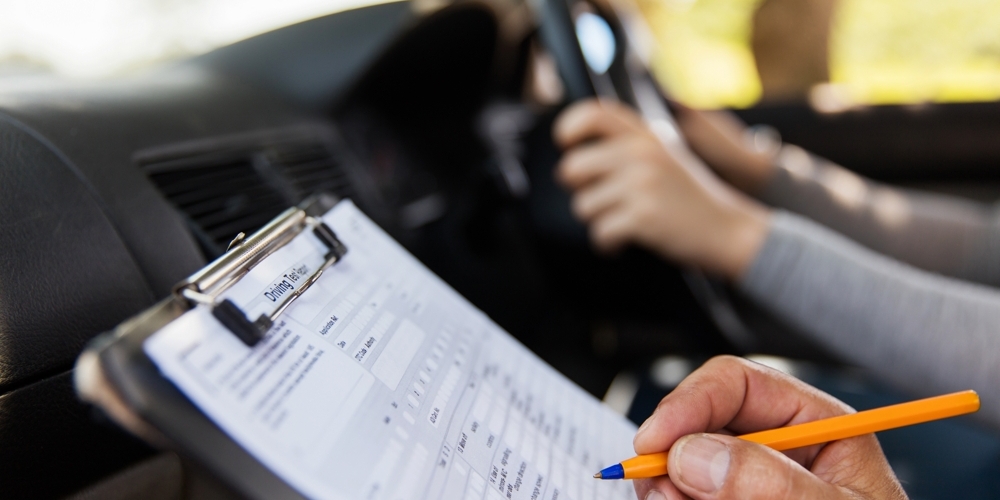
 This page has hints and tips about your practical test and how to get the best possible chance of a pass.
This page has hints and tips about your practical test and how to get the best possible chance of a pass.
The test will last for about 40 minutes and include a wide range of different roads. At the end of the test the examiner will tell you the result and briefly discuss the test.
When you pass, you will be able to apply for a full licence.
Whether you pass or fail you will be given a report form showing the mistakes that you made during the drive; this will help both you and your instructor to improve your future driving performance.
The most common reason that people fail the test is that they are not fully prepared - they attempt the test before they are ready. If you are unlucky and you fail the test it will be because the examiner considers that you would pose a risk to yourself or to others if you were to drive alone.
Key test advice:
Take your driving instructor's advice about when to take the test...
If you feel that you are ready and your instructor disagrees, no problem, simply get an independent assessment with another instructor.
If you take the test before you are ready and you fail, it could cost quite a lot of money in additional lesson time and test fees, plus the disappointment. But there is potentially a worse outcome... If you are not ready and by some fluke you manage to pass you will have a high accident risk when you are driving alone – this could end up costing you far more than just money.
You can find the full Government information about the driving test here.

When you have worked through the DriverActive Online programme and followed your instructor's advice about the timing of your test, you will be ready to pass.
The final step will be to ensure you can use that knowledge and skill under driving test conditions.
To ensure that you can meet the required standard of driving under test conditions, ask your instructor to give you a mock test (or preferably a series of mock tests).
The mock test should be as near as possible to the real thing, Ideally in the same area and at the same time of day.
Unlike a normal driving lesson, a mock test is completed without interruption.
If you make mistakes (which everyone does!) your instructor will not tell you about them until the end of the session. This approach can make some people feel nervous, effectively driving 'alone' for 40 or 50 minutes - but this is great preparation for the test and beyond.
Sometimes drivers feel that they have failed the test after a minor mistake which would not fail them - if they are not able to cope with the feelings of "Am I doing OK?" they can end up doing something silly that would definitely result in a fail. Mock tests will help you to 'keep your nerve' even if you feel uncertain.
Learning to 'keep calm' is also a benefit after you pass - sooner or later, you will be driving in new places... Being able to stay calm in all driving situations is an essential skill for all drivers.
Just like the real test, your instructor wants to see you using your usual driving skills during the mock test. Putting on a 'special performance' would defeat the object of a test that's designed to ensure that your everyday driving standard is safe.
The primary purpose of a mock test is to help prepare you for the real thing, not to check if you are ready for the test.
If you are not ready for the real test, you are not ready for a mock test.
You should be able to drive for about forty-five minutes without help and without making a serious* error before you do your full mock test.
*A serious 'driver error' is one that could lead to an accident, either in a different set of circumstances or if the examiner or other road user had not taken action to avoid the danger. If you can't drive without making serious errors, you will have little or no chance of passing the test.
It's no use relying on good luck alone!

Book online or get full details of how to apply for a driving test by clicking here.
Important: The link above is to the official DVSA Booking Service - there may be other companies that provide a booking service but if you use these you may end up paying more for the test There have also been a number Of scam booking sites in the last few years. If you are unsure, ask your driving instructor for advice..
Tests are generally done on weekdays between 8.30am and 4.30pm. However, in some areas it is possible to book a test for weekends or in the evening on weekdays.
If you are disabled, you can make special arrangements for a test of extended duration. In this instance, you will drive for the same length of time as other candidates; the longer appointment is provided for any additional administration or extra time needed to get into your vehicle.
If you wish to cancel your test appointment after it has been booked you can do so without losing your fee as long as you give three working days' notice (excluding bank holidays and weekends).
Following Covid and the associated lockdowns, test waiting lists became very long. There are still waiting lists up to six months in some regions (February 2023) and it's estimated that it could be mid 2024 before waiting times drop to pre pandemic levels. Ask your driving instructor about the availability of test cancellation slots.
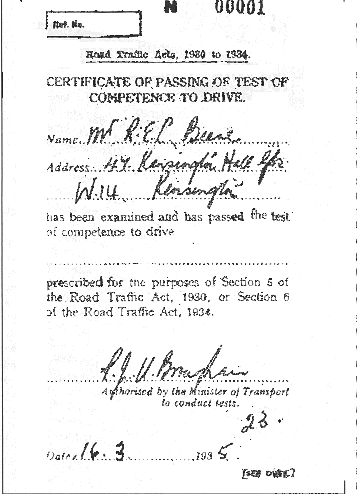
The compulsory driving test was introduced in 1935 - the first person to pass the test was Mr R.E.L. Beere who paid seven shillings and sixpence for the test appointment - that's around 38p in modern money!
The image shows Mr. Beere's famous test pass certificate.
Since that first test, there have been many changes, the most recent being in 2017 when the three-point-turn and corner reversing manoeuvres were dropped, and the time spent on the independent driving part was doubled. The video in this lesson shows the way it was done way back in the 1930's.
You can see the history of the driving test and other info on the Government website.
The single most common reason for test failure is that people attempt the test before they are ready. This has always been the case! Driving test examiners will confirm that as many as 25% of all those taking the test are so ill-prepared that they wouldn't even pass with luck on a good day!
The driving test pass-rate hovers around the 50% mark. It's been much the same since the 1950s. However, there are variations around the country, with the lowest area pass rates around 35% and the highest over 70%.
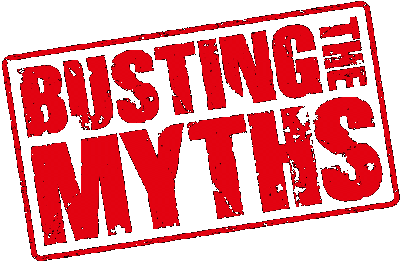
When it comes to practical driving tests, there will always be someone willing to give free advice about what will or won't happen on the day and what you should or shouldn't do.
Much of what you hear will be rubbish – people prefer to make up stories than to accept that they were just not good enough on the day.
They never pass people on Fridays
Move your head a lot when you look in the mirror
It's best to drive slow to show that you are careful
Mr. Jones never passes young men on their first attempt
Examiners fail everyone as soon as they have used up their quota of passes for the week
The driving test centre in the next town is much easier
These are just a few of the hundreds of reasons people give for failing. If you have listened to your instructor and are fully prepared for your test, you will find the test is easy. But the reality is that you will pass or fail on your own merit.
Remember, your instructor's advice is not free! You pay your instructor because they have studied the subject and deal with tests every day; instructors know much better than well-meaning friends and family about what happens on the test.
It might seem strange but passing the test does not mean that you are a good driver. However, it does mean that a highly trained examiner considers that you are skilful and safe enough behind the wheel to continue learning on your own without further assessment.
The best way to give yourself a test guarantee is to follow the DriverActive Course to ensure that you fully understand what is needed, get plenty of practice, and get as much tuition from a qualified instructor (ADI) as possible.

Driving test centres vary in size and layout - some are in shops in the town centre, others in purpose-built buildings. Some have car parks; others have on-street parking. But no matter the physical layout, they all serve the same purpose. The test centre is the place where you will meet your test examiner and start and finish the drive.
The examiner's job is to watch you drive and complete a report on your performance - if your drive meets the standard, you pass. If not, you fail.
Driving test examiners do not try to trick you or catch you out; they will be as helpful as possible. If you are unsure about anything, just ask.
Because of the nature of the job, examiners sit quietly and do not talk unnecessarily - this could be a distraction for you. Ironically, silence is a distraction for some people, so completing a 'mock test' is vital to get used to the testing process.
Sometimes the examiner's supervisor will sit in the back of the car to ensure that examiners do their job fairly and efficiently and according to the regulations. At the start of the test, the examiner will ask if you would like your instructor to sit in the back. If the instructor does come with you, they will not be permitted to speak during the test.
Having your instructor along can be helpful, pass or fail because they can give a clear and objective opinion of how you performed. Some instructors offer a 'written report' service with details of your test drive.
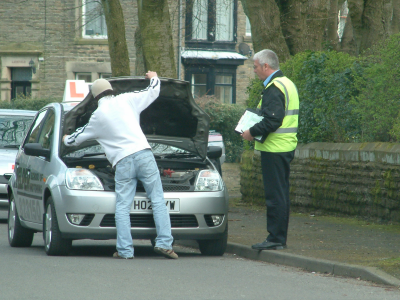
The test starts in the waiting room. Make sure that you arrive on time, otherwise you might lose your test and the fee.
The examiner will come out and ask you to sign a form; he/she will check your theory test certificate and licence. Your licence is checked to make sure that it is current and is valid for the vehicle that you are being tested in. The test cannot go ahead if you do not have your licence with you.
For a full list of documents for all tests click here.
After the document check is complete, you will be asked to lead the way to your car. On the way, the examiner will check your eyesight by asking you to read a car number plate.
Before the drive begins you will need to answer a vehicle safety check question - then, while you make yourself comfortable in the driving seat, the examiner will note the make and registration number of the car and will check that it complies with the regulations.
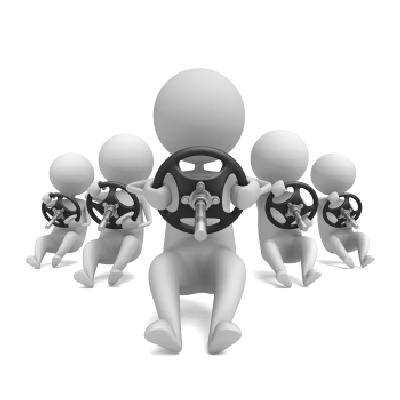
Before asking you to drive away, the examiner will briefly explain the test procedure to you.
'You should drive in your normal manner. Follow the road ahead unless road signs or markings indicate otherwise or unless I ask you to turn right or left.'
Expect the examiner's language to be formal, but polite. For example:
'Take the first road on the left, please'
'I would like you to turn your car around in the road to face the opposite direction'
'I'm pleased to tell you that you have passed'
If you are unsure about any instruction, ask the examiner to repeat it. Don't ask questions about how you should drive the car, these would meet with a polite answer of, 'Do what you would normally do' or something similar.
You will be required to demonstrate one of the exercises below (the examiner chooses which one) - you might also be asked to do an emergency stop exercise.
Reverse (parallel) parking
Reversing into a parking bay
Driving into a parking bay and reversing out
Stopping on the right and reversing in a straight line

The test includes approximately 20 minutes of independent driving - to enable you to do this the examiner will ask you to to:
Follow traffic signs
Follow a sat-nav (supplied and pre-programmed by the examiner)
The examiner will explain what you have to do in advance. You’ll have to follow sat-nav directions or signs. If you need help, you can ask the examiner, who will remind you about where you are heading,
You won’t fail for making a wrong turn as long as you don’t make a driving mistake. But remember that you are being tested on your ability to follow signs or a sat-nav while driving safely.
For example:
If you arrived at a roundabout and stopped to ask the examiner which way to turn, you could be holding up traffic, this would be marked as an error and could be a fail if you were in a dangerous position.
If the examiner asks you to follow road signs to a place of their choice – maybe the railway station, or a particular part of town, and during the drive you ask whether you should turn left or right, it means that you’re no longer looking for signs, but asking for guidance. If you’re unsure where you’re supposed to be going, it’s OK to ask the place name. The examiner can only tell you where you need to head to; they can’t tell you how to get there. It’s up to you to follow the signs.
The examiner will supply and programme the driving test sat-nav, you won’t be allowed to use your own.

Even if you are using a driving school car for the test, it is your responsibility to ensure that it meets all the legal requirements of roadworthiness, road tax, and car insurance and that it is fit for the test in line with current regulations.
It's reasonable to assume that your instructor's car will meet all the requirements. If not, you will probably have a valid claim against them - but always check the terms under which the car is supplied for the test.
The car used for your driving test must:
Be taxed, insured and in a roadworthy condition
Display L plates to the front and rear (or D plates in Wales)
Have mirrors that enable the driver to see following traffic clearly while seated in the normal driving position
Have an additional rear-view mirror fitted for the driving test examiner
The front passenger seat must have a functional seat belt and head restraint
Have all lights, indicators, brake lights, horn and other essential equipment (seatbelts, etc.) in working order
Be fitted with undamaged tyres that meet legal requirements
Have clean and clear windows – 'L' plates must not be displayed in front or back window
You must:
Wear spectacles or contact lenses if you normally need them for driving
Have the required documentation
Be in a fit and proper condition to drive. This means that it is never appropriate to have a drink, even a small one, to calm your nerves. Remember – drinking alcohol and/or taking drugs before driving is extremely dangerous.
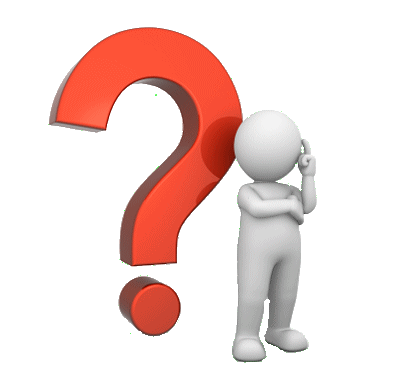
Q. Is it as easy to pass the driving test as it used to be?
A. The test is more rigorous than it used to be. It lasts longer, the roads are busier, the marking is tougher and there's more extensive testing of manoeuvres.
It takes longer to prepare for today's test that it did years ago but it's still easy to pass for those who are fully prepared.
Q. How long will the test last?
A. About 40 minutes.
Q. Which manoeuvres will I have to do?
A. You may be asked to do any of the following manoeuvres:
Reverse (parallel) parking
Moving off at an angle from behind a parked vehicle
Reversing into a parking bay
Driving into a parking bay
Stopping on the right and then reversing in s straight line before moving off again
You might also be asked to perform an emergency stop.
Q. Is there anything I need to do if I take the test in my own car?
A. Yes - you must fit a rear view mirror for the examiner's use. Your car must also comply with all the normal regulations. You'll find a list of cars that can't be used here.
Q What kind of roads will I drive on?
A. The routes are designed to ensure that you can drive safely in a wide range of conditions. Wherever possible, the routes will include: town centres, suburban roads, dual carriageways and rural roads.
Q. My friend had two examiners in the car - is that fair?
A. A senior DVSA examiner sometimes sits in the back to ensure that the examiners are doing their job properly and not failing people who should pass - this ensures a fair test for everyone.
Q. Can I drive an automatic car after I pass?
A. if you pass in a manual car, you can also drive an automatic, however, if you pass in an automatic you will have to take a separate test in order to drive a manual.
Q. My friend told me it's best to drive slowly during the test to show that I am safe, is this right?
A. The speed you drive will be determined by the speed limit, traffic and weather conditions. You can fail for going too fast, but you can also fail for going too slow or being hesitant.
 Q. How are my mistakes marked?
Q. How are my mistakes marked?
A. The examiner will keep track of your drive on a form (Driving Test Report). The form lists a number of items that relate to your control of the car, its equipment and your procedure on the road.
There are three categories of mistakes that can be recorded.
Dangerous faults: these are marked if your actions actually cause danger.
Serious faults: these are faults that could be dangerous in a different set of circumstances or are habitual errors that are potentially dangerous.
Driving faults: these are less serious errors that detract from 'perfect drive'. A single dangerous or serious fault will lead to test failure.
You are permitted a maximum of 15 less serious 'driving faults' although it is unlikely you will make anywhere near that many.
Q. Does each examiner have a quota of passes?
A.
No - examiners are checked regularly to ensure that they are doing the job correctly; if you drive well, you will pass, regardless of how many passes the examiner has awarded that day or week.
Q. What happens if I fail?
A. At the end of the test the examiner will explain the reasons for your result and you will get a test report.
Q. What happens when I pass?
A. The examiner will offer advice about your driving and issue a pass certificate – you are now licensed to drive on your own!